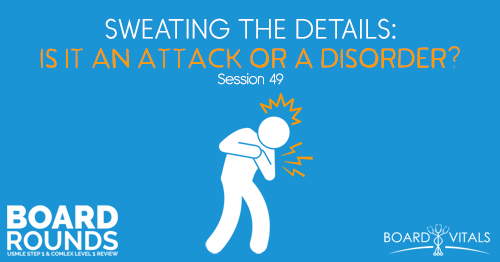Apple Podcasts | Google Podcasts

Session 07
We often associate biochemistry with undergrad, but biochemistry is present in many specialties! Let’s dive into the types of biochem questions you may see!
We’re joined once again by Dr. Andrea Paul from Board Vitals as we help you prepare for your first board exam so you have what it takes to score high and match into your specialty of choice. Use the promo code BOARDROUNDS to save 15% on your QBank purchase.
[03:30] Why Biochemistry?
Biochemistry is more applicable to some specialties than others. But just basic genetics and metabolic diseases, for instance, are seen in many specialties. Biochemistry comes into play especially when you talk about metabolic diseases. Hence, it’s a commonly tested subject on the exam, more than the other basic science components.
[04:41] Question for this Week:
A healthy married couple has a child who develops clinical symptoms of what you suspect to be a rare disease. Genetic testing revealed the patient’s mother carries the mutated gene, but the father is not a carrier. However, the father’s brother had the same disease, which has also occurred in one of his sisters’ sons.
This pattern is characteristic of which of the following diseases?
Note from Andrea: The question is drawing you a pedigree. You can jot down a little diagram of pedigree for yourself as you’re going through it. You have to figure out the pattern from the pedigree but know which diseases of the options fit that pattern of inheritance.
Answer choices:
(A) G6PD
(B) Cystic fibrosis
(C) Phenylketonuria (PKU)
(D) Alpha-1 antitrypsin deficiency
(E) Tay-Sachs Disease
[05:50] The Thought Process Behind the Answer
Once you’ve drawn that pedigree and determined what the inheritance pattern is, you can go through each option and cross out what doesn’t fit or jot down what pattern each one has.
In this case, the couple is healthy and not showing any disease. But the one child does and the father is not a carrier. This gives you another hint. So if he’s not a carrier, how is that possible if the child is showing the disease?
Then you’re seeing that it’s present in the father’s brother and one of the sisters’ sons. Here, you can see a distinctive pattern where this is not an autosomal recessive type pattern. This leads you to a dominant X-linked route.
As you draw this out, you will start to see the pattern where the children follow up to them. The mother is a carrier, the father is not. And the child has the disease. It’s likely that the child is a male because they’re receiving only an X from the mom. So this would be an X-linked pattern. Now, you would only see one that follows that X-linked disease – G6PD
Looking at patterns and pedigrees can really help you. Another algorithm Andrea found helpful is to ask: does the child with the disease have a parent with a disease. If no, then you’re skipping a lot of things.
You’re left here with X-linked recessive which is 50% more common than a male child. Therefore, it’s an X-linked recessive disease.
[11:02] Tips and Tricks to Help You Memorize and Understand Better
Most students are using mnemonics to remember all of the X-linked recessive diseases. This is most common for autosomal recessive or autosomal dominant. There’s no way to think through them in a way that doesn’t require memorization. The names of the disease don’t really help in this case. All this being said, Andrea recommends using mnemonics. You can also use visual mnemonics you can look at or silly drawings to help you remember stuff.
[12:37] Other Possible Questions
Probably, if the question talked about a food that this person that this person may develop symptoms with, then you could probably remove some answer choices out. For example, G6PD is one of those diseases. If it’s cystic fibrosis, they could ask what microbe commonly infects patients with this disorder. Or they could ask a treatment for that disorder.
[14:00] Other Patterns Students Should Know About
One pattern would be X-linked dominant. In this case, you would not see skipping of generations unlike what’s in the above question. You would also see male and female as affected equally since the disease of the X chromosomes is dominant. So you think of diseases like X-linked dominant Alport syndrome or hypophosphatemic rickets.
Another interesting inheritance pattern is mitochondrial where males and females are affected equally. It would skip generations but it is only transmitted from an affected female because mitochondrial diseases come from the maternal side always. And you would see a different pattern and all of the offspring would be affected – something you wouldn’t see in the other types.
Autosomal dominant, you would also see male and female as affected and not skipping generations. For instance, if two parents without the disease have a child with the disease, you’d think that the only way this could be autosomal dominant is there’s a new mutation or there’s some type of reduced penetrants or maybe the parent has the gene but just phenotypically normal. Otherwise, you would see this in every offspring because it’s a dominant disease.
Autosomal recessive is the opposite where you see skipping of generations. For example, if you have a couple both carrying the gene without any signs of disease, there would be 25% the child is born with two normal genes from the parents, 50% chance that they have one normal and one abnormal gene, and 25% that they would receive both. Since it’s recessive that’s the only case where you would see disease such as cystic fibrosis, thalassemia, sickle cell anemia, or PKU (of which some are shown in the answer choices above).
Spinal muscular atrophy would be a more popular disease here, which my daughter has but me and my wife don’t have, which makes us both carriers. This is going to be more popular to start talking about it on medical school and the boards because it’s one of the first diseases out there that will be cured with gene therapy.
[17:45] Board Vitals
If you’re interested in the QBank and how Board Vitals can help you prepare the best way you can for your Step 1 or Level 1, check out their site and use the promo code BOARDROUNDS to save 15% off of your QBank purchase.
Links:
Board Vitals (promo code: BOARDROUNDS)
SEARCH SITE
LISTEN FOR FREE











